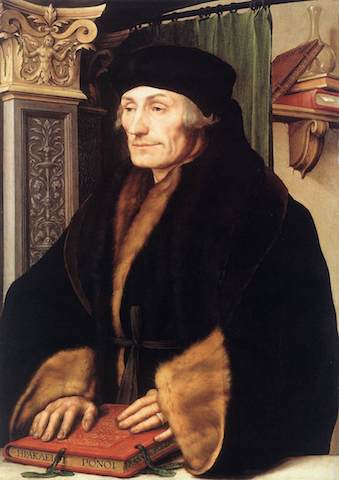Week 27
Above you see the brilliant portrait of Erasmus by his friend Hans Holbein. Erasmus was famous much before Luther. And his achievement of publishing and New Testament in Latin and Greek provided Luther with much of the work for his own German Bible. Erasmus and Luther shared much in their mutual disdain for the corruption of the Roman church. But Erasmus stopped short of breaking completely with Rome. Thus, Luther and Erasmus show us two possible roads in the early 16th century: one led to total rebellion and the other one led to the reformed Roman church.
RECOMMENDED READING:

John Hale,
The Civilization of Europe in the Renaissance,
Scribner, Reprint edition (June 1, 1995),
ISBN 0684803526
RECOMMENDED READING:
This is a beautiful book which covers the whole of the Renaissance in every field and every country. Margaret King is one of the greatest American scholars of the Renaissance, and she has written a very useful general book on the subject. What is especially attractive, is all the extra material: the charts, the maps, the photos, all of which make this a great study of the Renaissance. It would be a useful "textbook" for our whole year on the Renaissance. It was, of course, designed as a college textbook for a course on the Renaissance. If you buy a new copy, it is 35$ but there are many used copies listed on Amazon.
Margaret L. King, is Professor Emerita of history at Brooklyn College and the Graduate Center, City University of New York. She is the author of several books on women, humanism, and Venice in the Renaissance, and is currently editor-in-chief of the Renaissance and Reformation online bibliography published by Oxford Bibliographies.

Margaret L. King,
The Renaissance in Europe,
Laurence King Publishing; 2 edition (January 1, 2003),
ISBN 1856693740

Desiderius Erasmus,
The Praise of Folly and Other Writings,
Robert M. Adams, editor,
W. W. Norton & Company; 1st ed edition (October 17, 1989),
ISBN 0393957497
